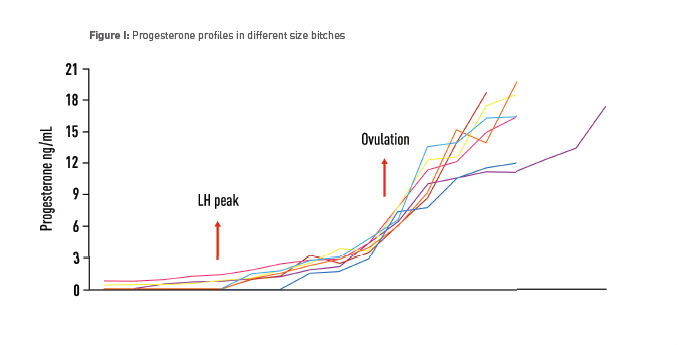As a breeder, you already know that when it comes to reproduction, the canine species is really unique. I have invested many hours over a number of years to help breeders develop a better understanding of how to be successful in the ultimate pursuit of producing healthy litters. Here is a short recap: Progesterone is secreted before ovulation in dogs, and we can use this characteristic of the canine estrous cycle to determine when the bitch ovulates. This is what we refer to as “timing of ovulation,” a great tool to improve fertility and prolificacy in your dogs since mistimed breeding is—by far—the most common cause of infertility in the bitch. When I was working at the reproduction center at the Alfort Veterinary School (Paris, France), these consultations were part of my daily routine. Here are 20 facts that might help you better understand the reasoning behind it.
- When to start? It is recommended to have the first consultation around six days after the beginning of the heat cycle. Sound too early? Well, always better sooner than later. Unfortunately, some bitches might ovulate as soon as this in their estrous cycle.
- Very often I had clients call me to say: “Doctor, my bitch is at [number] in progesterone. What should I do?” My typical answer: “[Number] what?” Wonder why? Progesterone results can be expressed in two different units: ng/mL OR nmol/L. We won’t interpret a result the same way depending on its unit.
- I have been asked to determine when the bitch would ovulate based on a single test. Most of the time that is not possible. (I told you I had bitches that ovulated six days after the beginning of estrus, but I also have had some that ovulated 30 days after!) At least three or four tests will usually be required over a number of days.
- “Do I need to come every single day until ovulation occurs?” No, this might be necessary when doing LH assays (another hormone secreted by the brain, which peaks two to three days before ovulation). LH secretion is pulsatile, and we need to detect a transient peak, so that’s why daily assays are needed in this case. On the contrary, progesterone will progressively rise during estrus, and this is the rise we will focus on when performing timing of ovulation.
- If progesterone is low (= basal value), typically we can wait four to five days before seeing the dog again.
- Progesterone is said to be “basal” when its blood concentration is below 1ng/mL.
- In figure 1 below, I highlighted the two main events we need to focus on when performing a timing of ovulation: the “LH peak” and “ovulation.”

Figure 1 - LH peak usually occurs when progesterone levels reach 2-3ng/mL. When this level is reached, ovulation will occur two to three days later.
- Never stop timing ovulation when you think you have passed the LH peak. You still need to detect ovulation. Some bitches might indeed have what we call an anovulatory cycle.
- What’s an anovulatory cycle? A cycle that does not lead to ovulation (and obviously then, the bitch will not get pregnant). Progesterone might rise because of the growth of the ovarian follicles containing the oocytes but suddenly drop (we still don’t know why). Follicles will simply shrink and disappear, and ovulation will not occur. I had a bitch that went as high as 4.9ng/mL in progesterone, but then dropped.
- Ovulation occurs when progesterone blood levels reach 5-6ng/mL.
- This value is the same whatever the size of the dog. Whether you have Chihuahuas, Labrador Retrievers, Mastiffs, etc., bitches will always ovulate around the same progesterone level. Take another look at Figure I, and you’ll see that at the time of ovulation, the different curves all overlap each other.
- We know the progesterone level at the time of ovulation. However, at the time of breeding, there is no “ideal” level. When fertility is optimal, progesterone values might be around 10, 30, sometimes even greater than 60ng/mL. The breeding protocol should be determined based on the estimated day of ovulation. We cannot say that the bitch should be bred when she is at [any number] ng/mL of progesterone.
- Then why perform a progesterone test after ovulation? Progesterone blood levels will rise quickly after ovulation, and it is good to confirm that this rise occurs. Indeed, if a plateau (= progesterone levels stagnating around the same value) is observed, something is not right, and an ovarian cyst might be suspected.
- In fact, each time such a plateau is observed during the timing of ovulation, the bitch should always be carefully followed. This can indeed happen normally, but a plateau should not last more than three days. If there is any doubt, an ovarian ultrasound should be performed to be sure the surface of the ovaries look normal.
- The hormone progesterone is the same in all mammals (same conformation, same molecular size, same everything). So no need for specific canine assays. To tell the truth, all the machines that are used to assay progesterone in canines are primarily developed for the human market.
- Progesterone machines are not all the same. What I mean by that is, if the progesterone level was 5-6ng/mL on the machine I used in my clinic, it might have been 4-5ng/mL or 8-10ng/mL on another one. The value needs to be properly interpreted: It’s important to rely on somebody, therefore, who is used to working with the laboratory or the machine that gives the results, so they are properly interpreted.
- There are now in-house machines that can be used in veterinary clinics to assess progesterone. Like the one below.

Progesterone machine - It usually takes 18-20 minutes to run a progesterone test.
- You did a timing of ovulation, your bitch ovulated 17 days after beginning of her estrous cycle and she became pregnant. Does that meanthat next time your bitch will ovulate at 17 days again? Not necessarily. There are up to 40 percent variations between cycles. A timing of ovulation should therefore be performed at each cycle.
Emmanuel Fontaine graduated from the Toulouse Veterinary School in 2004. Dr. Fontaine continued his studies at the Alfort Veterinary School in Paris as a trainee veterinarian in the domestic carnivore unit of the Reproduction Department. From 2005 to 2011, he worked at the Centre d’Etude en Reproduction des Carnivores (CERCA) [Research Centre for Reproduction in Carnivores], a unit specializing in pet breeding assistance. Dr. Fontaine is also qualified at the European College for Animal Reproduction (ECAR) and recently completed his PhD. Dr. Fontaine joined Royal Canin Canada’s professional team as a Technical Support Veterinarian in September 2011.



